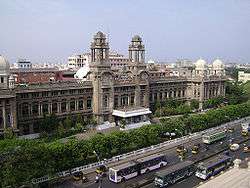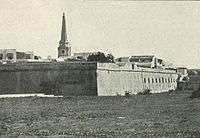Heritage structures in Chennai
Chennai, with historically rich records dating from the British era, houses 2,467 heritage buildings within its metropolitan area (CMA), the highest within any Metropolitan Area limit in India.[1] Most of these buildings are around 200 years old and older. Some of them are Chennai Central, Chennai Egmore, Ripon Building, Bharat Insurance Building, and so forth.[2] Chennai is home to the second largest collection of heritage buildings in the country, after Kolkata.[3] The official list of heritage buildings was compiled by the Justice E. Padmanabhan committee.[4]
Heritage activism
Heritage buildings are defined as notified structures of historical, architectural, or cultural significance.[5] The heritage activism in the city began with the erstwhile Moore Market building fire in 1985.[6] In 1997, the state government initiated action to conserve heritage buildings. After the second master plan for the city was approved by the government on 2 September 2008, special rules for conservation of heritage buildings/precincts came into force.[5] A 17-member Heritage Commission was set up on May 2012 to maintain these structures, after a fire accident in Kalas Mahal, a 244-year-old heritage building in front of Marina beach.[7] As per the Commission's mandate, heritage buildings that are listed will get incentives, such as exemption from payment of taxes, and offenders who deface or destroy them will face penal action.[1]
In 2012, a list of heritage buildings was released by the Chennai Metropolitan Development Authority (CMDA) under the heritage conservation committee's (HCC) supervision. Criteria considered for notification as heritage structure include period of construction, exhibited trend, events or persons associated with the structure, and design, style, designer, physical condition, and design integrity for architecturally significant buildings.[5] By February 2013, the CMDA is expected to clear the first list of 70 heritage buildings compiled by the HCC. Of the structures/precincts that figure on the list, 42 are government buildings and the remaining are private ones. The government buildings include the main building of the College of Engineering Guindy under Anna University, Madras High Court, General Post Office, Music and Dance College, Government Teacher Training Institute at Saidapet, and King Institute of Preventive Medicine. Theosophical Society is one of the private premises that are expected to get listed as a heritage structure. When a building is notified as a heritage structure, the onus of repair and maintenance of the heritage structure will be on the structure's owner.[5]
The structures will be categorised into three grades, namely, Grades I, II, and III. Grade I structures will be prime landmarks upon which no alterations will be permitted. Under Grade II, external changes on structures will be subject to scrutiny. Buildings under Grade III may be changed for 'adaptive reuse' with suitable internal and external changes.[5]
List of heritage structures
| S.No | Building | Architectural style | Year of construction |
Architect | Neighborhood | Notes | Image |
|---|---|---|---|---|---|---|---|
| 1. | Chennai Central Railway Station | Indo-Saracenic | 1873 | George Harding | Park Town | Built as a second terminus to decongest the Royapuram harbour station, which was being utilised for port movements. Built in a combination of styles, namely, Gothic and Romanesque.[8] |  |
| 2. | Southern Railway headquarters | Indo-Saracenic | 1921 | N. Grayson | Park Town | Originally built as the new Madras and Southern Mahratta Railway Company (MSMR) headquarters (successor of Madras Railway Company), replacing the general office of MSMR at Royapuram Railway Station. Built for the first time in India in reinforced concrete in classical and Dravidian styles.[9] |  |
| 3. | General Post Office | Indo-Saracenic | 1884 | Robert Fellowes Chisholm | George Town | Built at a cost of ₹ 680,000.[10] |  |
| 4. | Madras High Court | Indo-Saracenic | 1892 | J.W. Brassington, Henry Irwin | George Town | The court buildings are believed to be the second largest judicial complex in the world after the one in London. The complex also houses the largest number of courts in Asia.[11][12][13] |  |
| 5. | Bharat Insurance Building | Indo-Saracenic | 1897 | Anna Salai | Originally known as Kardyl Building | ||
| 6. | Chepauk Palace | Indo-Saracenic | Around 1764 | Chepauk | The official residence of the Nawab of Arcot from 1768 to 1855 |  | |
| 7. | Senate House, University of Madras | Indo-Saracenic | 1879 | Robert Fellowes Chisholm | Chepauk | Incorporates many elements of the Byzantine style.[14] The great hall of the Senate House is of immense height and proportions, considered to be the finest of its kind in India.[14][15] | .jpg) |
| 8. | College of Engineering | Indo-Saracenic | 1920[16] | Guindy | |||
| 9. | Government Museum Buildings | Indo-Saracenic | between 1789 and 1890 | Henry Irwin | Egmore |  | |
| 10. | National Art Gallery | Indo-Saracenic | 1906 | Henry Irwin | Egmore |  | |
| 11. | Egmore Railway Station | Indo-Saracenic | 1908 | Henry Irwin | Egmore |  | |
| 12. | Ripon Building | Indo-Saracenic | 1913 | Park Town | Built at a cost of ₹ 750,000. | ||
| 13. | Victoria Public Hall | Indo-Saracenic | 1888-1890 | Robert Fellowes Chisholm | Park Town | The venue of the first cinema show in Chennai. | |
| 14. | The Mail and P Orr & Sons | Anna Salai | |||||
| 15. | Christ Church | Anna Salai | Possibly the first congregation outside Fort St George. | ||||
| 16. | Suguna Vilasa Sabha | Anna Salai | Possibly one of the earliest drama theatres with stalwarts like Pammal Sambanda Mudaliar — now called SVS Club. | ||||
| 17. | Dargha of Sufi Saint Syed Moosa Sha Khaderi | 17th century | Anna Salai | ||||
| 17. | Agurchand Mansion, Cuddon/Gove Building | Anna Salai | |||||
| 18. | Higginbotham's | Anna Salai | The first and the oldest existing book shop in India. |  | |||
| 19. | King Institute of Preventive Medicine and Research | 1899 | Anna Salai, Guindy | ||||
| 20. | Royapuram railway station | 1856 | Royapuram | Third oldest railway station in the country and the oldest in South India.[17] |  | ||
| 21. | Fort St. George | 1640 | George Town | First major British settlements in India, leading to the foundation of the city of Madras. One of the 163 notified areas (megalithic sites) in the state of Tamil Nadu.[18] |  | ||
| 22. | Police headquarters | 1839 | Mylapore | Renovated in 1993.[19] | |||
| 23. | Amir Mahal | Indo-Saracenic | 1798 | Royapettah | |||
| 24. | State Bank of India Building | Victorian Architecture | 1897 | Col. Samuel Jacob | George Town |  | |
| 25. | Dobbin Hall | 1904–05 | Madras Veterinary College (now located opposite) started functioning. | ||||
| 26. | Government College of Fine Arts and Crafts | Indo-Saracenic | 1850 | Robert Fellowes Chisholm | Egmore | The first school of arts in Asia | |
| 27. | Archives-Record Office | Indo-Saracenic | G. S. T. Harris | ||||
| 28. | St Andrew's Church | Georgian church architecture | 1821 | Major De Havilland | Built at a cost of 20,000 UK pounds |  |
See also
References
- 1 2 Mariappan, Julie (10 July 2012). "Long history of service". the hindu. Chennai: the hindu. Retrieved 12 Nov 2012.
- ↑ Heritage building gets a breather
- ↑ Ravishankar, Sandhya (6 September 2007). "No fire safety norms at Chennai heritage buildings". IBN Live. Chennai: CNN IBN. Retrieved 20 Nov 2012.
- ↑ Ravi, Bhama Devi (18 April 2012). "Tamil Nadu's shameful disregard for heritage buildings". Sify News. Chennai: Sify News. Retrieved 12 Nov 2012.
- 1 2 3 4 5 Xavier Lopez, Aloysius (6 February 2013). "42 government buildings among 70 vying for heritage status". The Hindu. Chennai: The Hindu. Retrieved 11 Feb 2013.
- ↑ Sriram, V. (10 October 2008). "To market, to market...". India Today. Chennai: India Today. Retrieved 29 Nov 2012.
- ↑ Srivathsan, A (19 September 2013). "Heritage commission remains on paper". The Hindu. Chennai: The Hindu. Retrieved 20 Sep 2013.
- ↑ Kurian, Nimi (18 August 2006). "Long history of service". The Hindu. Chennai: The Hindu. Retrieved 3 Nov 2012.
- ↑ Venkataraman, G.; A. Anne Shanthi. "History of Historical Building and Monuments in and around Chennai" (PDF). CMDA Chennai. Retrieved 10 May 2012.
- ↑ Muthiah, S. (30 October 2011). "Madras miscellany — The Madras G.P.O. beginnings". The Hindu. Chennai: The Hindu. Retrieved 10 Mar 2012.
- ↑ "Madras High Court". BSNL. Retrieved March 2, 2012.
- ↑ "High Court Building". CHENNAI-DIRECTORY.COM. Retrieved March 2, 2012.
- ↑ Chandru, K. (26 Nov 2011). "Some thoughts around the Madras High Court". The Hindu. Chennai: The Hindu. Retrieved 27 Nov 2011.
- 1 2 Srinivasachari, Introduction, p 262
- ↑ Srinivasachari, Introduction, p xxxiv
- ↑ http://www.thehindu.com/features/metroplus/survivors-of-time-college-of-engineering-guindy/article2671458.ece
- ↑ "Third oldest railway station in country set to turn 156". Deccan Chronicle. Chennai: Deccan Chronicle. Retrieved 27 Jun 2012.
- ↑ Madhavan, D. (20 December 2012). "National Institute of Siddha modifies expansion plan". The Hindu. Chennai: The Hindu. Retrieved 23 Dec 2012.
- ↑ Iyengar, Pushpa (2 June 2008). "Cornered Stones". Outlook India. Outlook India.com. Retrieved 19 May 2012.